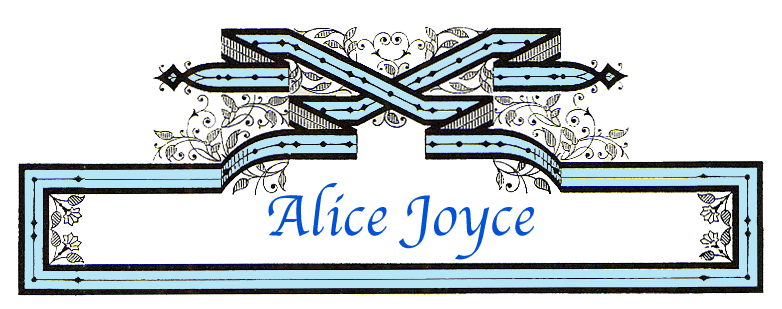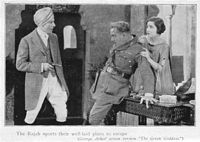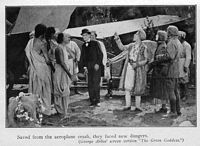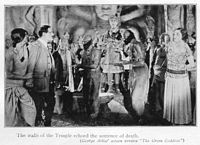

The Green Goddess (1923) Distinctive Productions. Distributor: Goldwyn-Cosmopolitan Distribution Corp. Director: Sidney Olcott. Adaptation: Forrest Halsey. Photography: Harry Fischbeck. Musical Score: Joseph Carl Breil. Gowns by Lucile. Cast: George Arliss, Alice Joyce, David Powell, Harry T. Morey, Jetta Goudal, Ivan Simpson, William Worthington. Filmed at the Bronx Biograph studio. 8-10 reels
A copy of this film is located at the UCLA Film and Television Archives (35 mm, 5 [double?] reels (ca. 10000 ft.)). It was remade with Arliss and Joyce in the same roles in 1930.
Thanks to Derek Boothroyd for these scans. Click on thumbnails for larger view
 |
The Rajah upsets their well-laid plans to escape. | |
| Saved from an aeroplane crash, they faced new dangers |  |
|
 |
The walls of the Temple echoed the sentence of death. |
See also a still photo from the J. Willis Sayre photograph collection at the University of Washington.
Presented by Distinctive Pictures Corp., releasing through Goldwyn-Cosmopolitan. Adapted from William Archer's play of the same name by Forrest Halsey, starring George Arliss and featuring Alice Joyce. Directed by Sidney Olcott, with H. A. Fischbeck photographer. Special musical score composed by Joseph C. Breil. Opened at the Sam Harris theatre Aug. 14. Projection time, 106 minutes.
| The Rajah of Rukh | Mr. Arliss |
| Lucilla Crespin | Miss Joyce |
| Major Crespin | Harry T. Morey |
| Dr. Basil Traherne | David Powell |
| The Ayah | Jetta Goudal |
| Watkins | Ivan Simpson |
| The High Priest | William Worthington |
Distinctive Pictures may not have an unusual special with this screen adaptation, but there is little doubt "The Green Goddess" will suffice as an excellent program feature. The performance of George Arliss alone is enough to make it that.
Opening at the Harris Tuesday night for what is becoming a habit with the producing organizations (at the slightest suggestion they've "got somethin," a pre-release run) the film clicked regularly and often before a friendly audience. But despite that fact it may be said that the picture is "there."
Olcott, in directing, adhered closely to the stage presentation, with the sub-titles (at least 50 per cent of the entertainment's qualities) being lifted directly from the original script. Arliss far overshadows any other contributing member, some of whom were with him during the run of the play. In this respect Ivan Simpson, valet to Arliss, comes in for special mention because of a meritorious effort which ranks him second to the star.
Photography and lightings are splendid and the sets appropriate if not elaborate. Olcott did nicely with a meagre amount of mob stuff, possibly overtaxed his climax a bit, but inserted as a neat shot of an airplane squadron in flight as can be imagined. A corking bit, that.
The story tells of a Major Crespin, his wife and Dr. Traherne falling into the kingdom of Rukh due to a mishap to the doctor's plane. As three brothers of the Rajah (Arliss) are about to be executed by the English authorities the moment is opportune for revenge, and so demanded by the populace.
Mr. Arliss' highly educated and serenely satirical Rajah, who possesses an extraordinary sense of humor, is fully equal to his stage characterization. And to those who saw the play there need be nothing further said. Harry Morey as the Major was perhaps permitted too much freedom as the constantly liquored major and husband, with the result he has greatly overdone the strutting, quick-tempered and braggart type.
On the other hand, David Powell, as the doctor and lover, can be classified as of the modest, retiring and shy sort in comparison. Too much so, probably, and falls short of equaling Cyril Keightley's performance in the same stage role.
Miss Joyce, heralded in the program as returning to the screen for this special effort, lent a charming appearance and tone while making her role of the wife a quiet and subdued one, but convincing.
The program may suffer in a regular program house for those who happen to walk in on it failing to catch the initial viewpoint of the Rajah. But in the pre-release theatre, where everyone is seated at the start, the film entertains with its dramatics and cynical sub-titles.
It's another mark for Arliss on the screen. They can take all their previous Sheiks, Sultans and Rajahs and put them in the bag. For Mr. Arliss as the wise-crackin' Rajah, who regards women as strictly business while preferring to work on percentage, is the pay off.
"The Green Goddess"
Goldwyn-Distinctive Feature Starring George Arliss Provides Remarkably Fine Entertainment
Reviewed by C.S. Sewell.
When William Archer, the celebrated English dramatic critic, set out to write the play, "The Green Goddess," he sought to provide an entertainment which would have sufficient stirring dramatic situations to hold the ordinary theatregoer, combined with subtle humor and clever satirical lines that would appeal to the fastidious and intellectual. That he succeeded is evidenced by the fact that with George Arliss in the title role the stage production ran for fifteen months in New York and was successful on the road.
This story has now reached the screen as a Distinctive production, released by Goldwyn-Cosmopolitan, and is being presented on Broadway at two dollars top. The picture version is an exceptionally faithful adaptation of the play even to a duplication of the stage sets on a larger scale, the only real change being in the utilization of the larger possibilities of the camera for big exteriors, aeroplane flights and mob scenes which could only be suggested or shown in a limited way on the stage.
Mr. Arliss is also the star of the screen version and with him is Ivan Simpson as the valet who added greatly to the enjoyment of the play. The cleverest and most amusing lines have been retained, and really the only thing missing is the star's wonderful speaking voice.
The net result is a picture that ranks unusually high in entertainment value. It has thrills, tremendous suspense, fine comedy and excellent acting. It should even eclipse its stage record, and prove a tremendous box-office winner. Frankly a melodrama, it is a wonderful example of the type that does not depend on stunts for thrills but builds up to its thrills through ever-increasing dramatic force. It is a superb piece of dramatic construction, the situations build up and up with increasing power to a tremendous finish with no anti-climaxes, and the film ends with a particularly clever subtitle that will send them away smiling. As a consequence the interest of the audience is held in a vise-like grip.
George Arliss gives a wonderful performance. Nothing finer has been seen on the screen than his delineation of the character of the East Indian Rajah, a potentate who combines the veneer of white civilization with the cunning, craftiness and cynicism of the Oriental topping it all with an excellent sense of humor. He would appear to be the perfect embodiment of the author's conception. His calm, reserved and carefully modulated portrayal of a role that could easily be overacted adds a tremendous force and realism to the melodramatic story.
After an absence of many months, Alice Joyce makes her reappearance on the screen as Mr. Arliss' leading woman and gives a thoroughly satisfactory performance. Ivan Simpson as a typical English valet in Oriental surroundings contributes a fine piece of acting; Harry Morey is excellent as a British Major, Paul Powell gives a good account of himself in a role that has very limited possibilities, and Jetta Goudal is particularly well cast as an Oriental servant, and William Worthington as the native high priest.
Sidney Olcott's direction of this picture is distinctly high class from his handling of the mob scenes to the fine way in which he has developed the purely dramatic side. He has injected some remarkable aeroplane shots and the scene in the temple where the English are about to be sacrificed to the green goddess are unusually weird and effective.
Make no mistake, here is a picture that should immensely please any audience. It will both thrill and amuse them, and should prove a tremendous box-office success.
Cast.| Rajah of Rukh | George Arliss |
| Lucilla Crespin | Alice Joyce |
| Dr. Traherne | David Powell |
| Major Crespin | Harry T. Morey |
| Ayah | Jetta Goudal |
| Watkins | Ivan Simpson |
| High Priest | William Worthington |
Based on a stage play by William Archer
Adapted by Forrest Halsey
Photographed by Harry Fischbeck
Directed by Sidney Olcott
Length, 9,100 feet.
Story
Dr. Traherne starts out in an aeroplane from a point in the mountains of India to transport Major Crespin and his wife to a distant point where their children are staying. The plane breaks down and the three find themselves in the little known country of Rukh. While hospitably received by the Rajah, who is an Oxford graduate, they soon find they will be sacrificed to appease the wrath of the Green Goddess, as the English government is about to execute the Rajah's three brothers. The Rajah offers to save them if Mrs. Crespin will become his queen. She refuses. After a succession of nerve-racking experiences the Major succeeds in sending a wireless message for help, but is shot by the Rajah. The other two are about to be offered up as sacrifices when help arrives. Dr. Traherne declares his love for Mrs. Crespin and all bids fair to end happily.
This is a very entertaining film of a very entertaining play--one that is a lot of fun with the right actor in the lead role. George Arliss is wonderful as the witty but dangerous Rajah, and it's his film all the way. Alice Joyce is very well cast as the refined English matron upon whom he sets his sights. She is a worthy prize and opponent, and acts well when required--occasionally terrified, but more often just VERY put out by the exasperating Rajah, particularly his attempts to get her into a low-cut dress. The other men in the film pretty much pale into insignificance, but Jetta Goudal makes the most of her small role. A lovely print.
Print viewed: 35mm print from the UCLA Film and Television Archives, screened at the Stanford Theater.
Last revised December 27, 2015